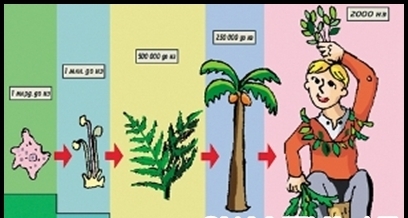IV. Define the tense of the predicate and put the sentences into the interrogative
and negative forms:
1. I am studying biology. 2. He has solved this difficult problem. 3. He is a good biologist. 4. My teacher developed a new plant. 5. These scientists work at a very interesting problem. 6. They began to investigate this problem last year. 7. Animals and plants live under different conditions. 8. Life exists in many places on the earth. 9. Some animals can exist under the immense pressure of the deep seas. 10. Biologists have solved many mysteries of the body. 11. Students of the biological faculty study different subjects.
V. Translate the text without a dictionary trying to guess the meaning of the
unfamiliar words from the context:
Biology gives us an acquaintance with the world of living things and an understanding of some of the great fundamental laws and processes of nature. There are many special fields of knowledge and many pha5es and principles to which elementary training in general biology is essential. These include medicine, physiology, agriculture, horticulture, forestry, sanitation, hygiene and many others.
Because man is an organism subject to the same laws which govern all living things and is built according to the same plan as other higher animals, an elementary knowledge of biology gives us a basis for an understanding of our own body.
BIOLOGY II
Biology is the science of living things. The word biology" comes from two
Greek words: bio — "life" and logos — "discourse" or "study". Biology includes all the facts and principles which have been derived from a scientific study of living things. The special study of plants, called Botany, and of animals, called Zoology, are the two great subdivisions of the science of biology. Plants and animals are called organisms, so biology may also be defined as the science of organisms.

Life exists in many places on the earth, often in spite of very difficult conditions. In the Arctic regions, the temperature may fall to 60 degrees below zero, while in deserts it may climb to over 120 degrees. Some animals live under the immense pressure of the deep sea, and others live near the tops of the highest mountains. But no matter where they exist, all living things must have certain necessary conditions. Let us see what these are: living things need oxygen, living things must have the right amount of pressure, living things must have water, living things need the proper temperature, living things must have food.

Most people think that plants are not alive in the same sense that animals are, or that there is some fundamental difference between plant and animal life. But this is not so.
Plants and animals have much in common. Their more important points of resemblance are:
1) The living substance of plants and animals is organized into protoplasm.
Protoplasm is the basic material of all living systems and its general properties are
fundamentally the same in each system both in plants and animals.
2) The living matter is organized in both plants and animals into microscopic
units called cells.
3) Certain vital processes take place in plant bodies in the same manner as in
animal bodies. These processes are respiration, digestion, assimilation, growth and
reproduction.
4) Both animals and plants cannot live without water, air, food, light and moderate amount of heat. They both are of different shapes, sizes and colours. In fact, the differences are not so many as the likenesses although they are more apparent, for only three are important, namely: plants are not conscious, they are unable to move about, they make their own food.
Notes to the text:
1. In the same sense— в том же смысле, что и ...
2. of the same kind— того же вида, сорта
3. to be certain — быть уверенным
4. no matter — неважно, безразлично
5. in spite of — несмотря на
EXERCISES